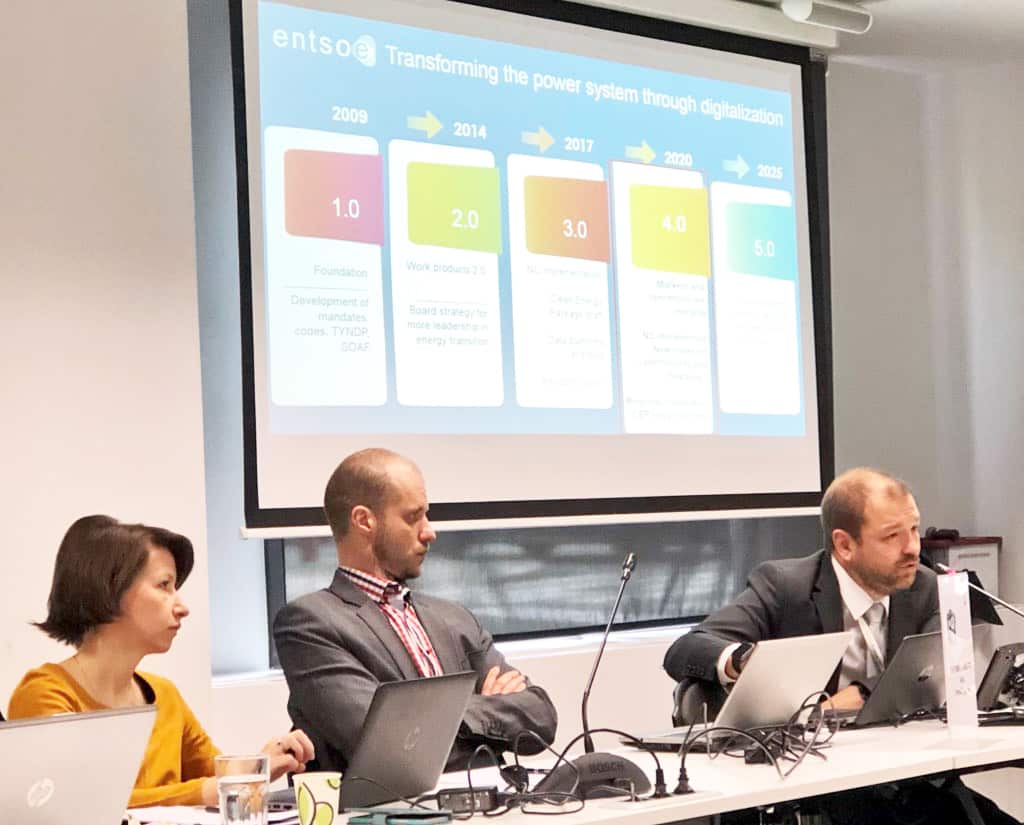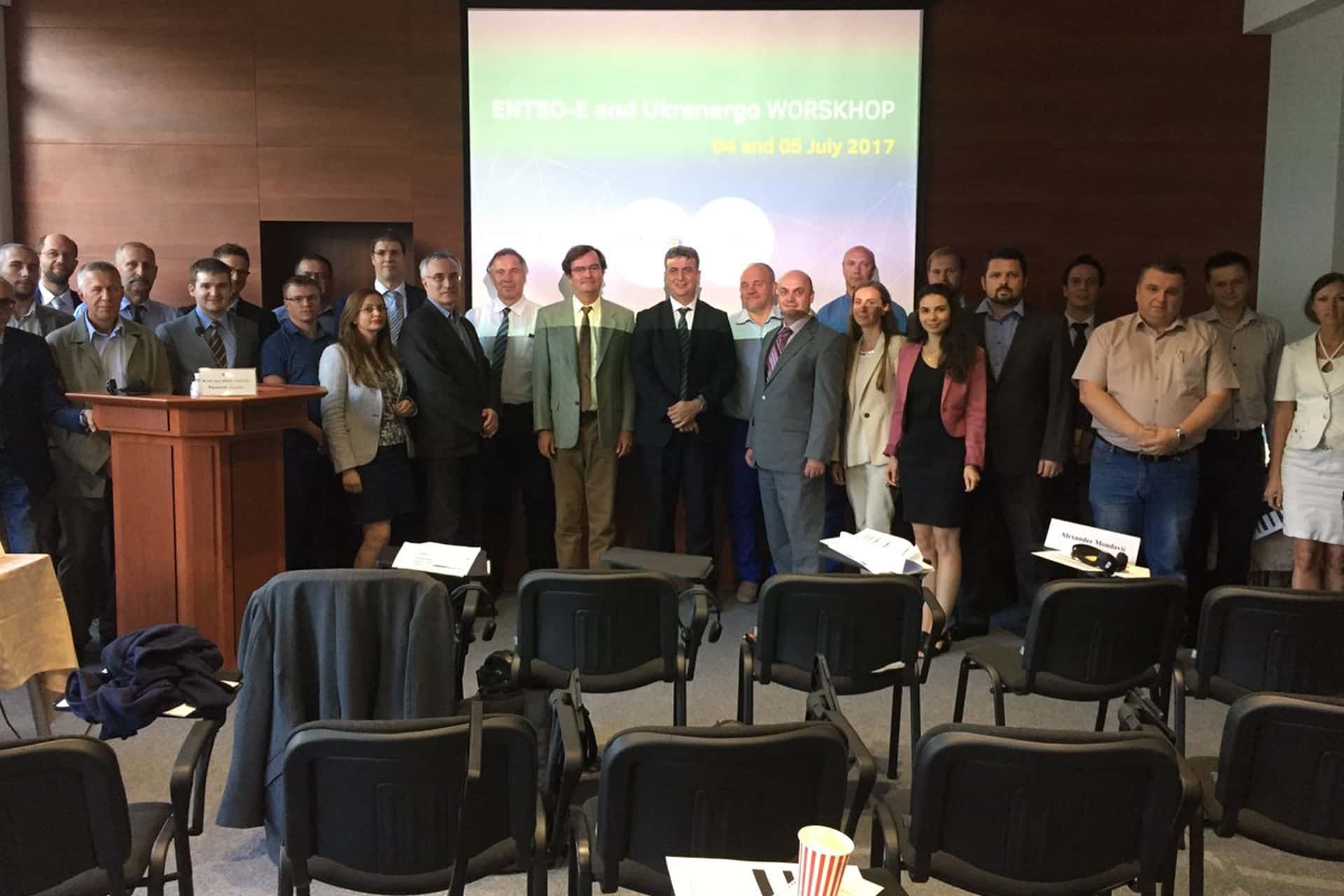TSO coordination and digitalisation
One of ENTSO-E’s mandated tasks is to support TSOs in coordinating their efforts and to develop information networks and procedures that can help them achieve Europe’s energy policy goals. Several factors render coordination among TSOs more important than ever, e.g., increased variable generation, more interconnections. TSO coordination is fundamental to maintaining the security and quality of the network supply; it is also important to adequately plan infrastructure investment at the regional level, and to improve operational cost efficiency (see the Regional Security Coordinators, under ‘Network codes’). Additionally, ENTSO-E sees digital technologies as an opportunity to foster coordination even further. 2017 saw the establishment of a digital committee advising ENTSO-E’s Board, reflecting this new priority. The important budget increased decided at the end of 2017 is another example.

Digitisation enabling more coordination: ENTSO-E’s Common network operation tools
In addition to the Common Grid Model (see under ‘Network codes’), TSOs have developed several common operation tools that allow them to better coordinate.
ENTSO-E shall adopt common network operation tools to ensure coordination of network operation in normal and emergency conditions, including a common incidents classification scale (Article 8(3)(a) Regulation 714/2009)
The ENTSO-E Awareness System
The ENTSO-E Awareness System (EAS) is the technological platform allowing TSOs to exchange information in real time. It allows TSOs to monitor energy flows and the state of the network across Europe as it happens. Operational since 2013, it is used by all TSOs with interconnections.
Quarterly EAS user tests performed in 2017 under the lead of the two Hosting Entities (Amprion and RTE) showed the tool was fully operational. ENTSO-E began a project in September 2017 that focuses on upgrading the European Awareness System, for both the hardware and the software part. In addition, the team in charge of keeping up-to-date the EAS operational procedure engaged in an alignment exercise to ensure consistency between the EAS statistics and the Incident Classification Scale reporting14.
Following the entry into force of the SOGL in September 2017, ENTSO-E began to review all requirements in the SOGL to ensure the compliance of the tool.
14 Requirement under Regulation (EC) 714/2009 where TSOs are asked to develop a common incidents classification scale
The Electronic Highway
The electronic highway is a meshed router network (separate from the internet) connecting the European TSOs, and is designed for real-time data exchange between them. It is being used by the 38 TSOs directly connected since 1999.
A security analysis performed in 2017 revealed several issues with the Electronic Highway. Considering these issues, the decision was taken to merge Electronic Highway with ATOM, the data exchange communication network used for the Common Grid Model15. This will create one single physical infrastructure for TSOs’ communication network. The new infrastructure will be called COMO (Communication Network for Market and Operations) and will support multiple services.
Besides, ENTSO-E finalised in 2017 an (internal) Security Framework for the Protection of Electronic Highway and ATOM, consisting of a set of minimum security requirements for physical, organisational and cyber aspects that are expected to be implemented by each TSO.
15 ATOM is a pan-European private network based on TSOs’ owned backbone network. It allows the exchange of non-real-time operational and market-operations related data.
Cybersecurity
Protecting TSOs’ systems and network operation tools against cyber-attacks is obviously of paramount importance for the security of electricity supply. ENTSO-E supports TSOs by acting as a platform to share best practices.
In May 2017, ENTSO-E signed a Memorandum of Understanding with the European Network of Cyber Security (ENCS), with the objective of developing a partnership in the cybersecurity area. The focus will be on developing good security regulations and effective cybersecurity practices.
ENTSO-E TSOs joined the Red Team – Blue Team training organised by ENCS in December 2017. The goal of the course was to raise awareness of Industrial Control Systems (ICS) cyber security risks, to share knowledge of attacks and defensive measures and to experience hands-on practices of cyber security within the ICS domain.
In addition, ENTSO-E is participating in the European Commission Smart Grid Task Force, EG 2 – Working group on Cybersecurity. The working group focuses on energy networks and prepares the ground for a possible network code on cyber security.
A new IT governance
ENTSO-E and TSO, and all electricity market players, are engaged in a digital transformation, as exemplified by the rise of smart grids and the development of tools such as the Common Grid Model and the Operational Planning Data Environment. The IT architecture must be adapted to allow TSOs and market players to take advantage of this transformation for designing more efficient processes and methods.
ENTSO-E elaborated in 2017 an IT strategy, spanning the period from 2017 to 2020, including as a first concrete step the creation of a Digital Committee to advise ENTSO-E’s Board on digital.
Cooperation with third country TSOs
ENTSO-E released in January 2017 a report presenting recommendations for the coordination of technical cooperation between Union and third Country TSOs16, as required by Regulation 714/2009 Article 8(3)(c). The report sets a non-binding framework for technical cooperation, to be continuously improved in future.
ENTSO-E shall adopt recommendations relating to the coordination of technical cooperation between Community and third-country transmission system operators (Article 8(3)(c) Regulation 714/2009)
Areas for cooperation include data sharing and information, knowledge-sharing, technical standards, network development planning, coordinated system operation, protection of critical infrastructure including cyber-security, and interconnection. ENTSO-E’s role is to facilitate the cooperation and coordination between TSOs, to ensure effective and transparent access to the transmission networks and to provide coordinated and forward-looking planning.
2017 also saw closer ties with the Ukrainian TSO Ukrenergo and Moldovan TSO Moldelectrica. Two agreements, signed between Ukrenergo/Moldelectrica on the one hand, and the TSOs of Continental Europe on the other, entered into force in July 2017, specifying the conditions for the future interconnection of the power system of Ukraine and Moldova with the power system of Continental Europe. Ukrenergo and Moldelectrica will have to implement within the next five years a catalogue of measures, including a series of technical requirements. These agreements open the way to a possible synchronous connection of Ukraine and Moldova with the Continental European power grid within the coming 4 to 6 years.
In addition, in July 2017, ENTSO-E organised in Kiev a workshop with Ukrenergo to discuss electricity system development, market and operations. Data concerning the Ukrainian power system has become available on ENTSO-E’s real-time market data platform (Transparency Platform). 2017 also saw the Albanian TSO OST join ENTSO-E as a member.
16 To be understood as TSOs who are not member of ENTSO-E

Synchronisation of Baltic countries to Continental Europe
Baltic States are currently synchronised with the IPS/UPS system from Russia and Belorussia. However, the Baltic States have expressed their wish to be part of the Continental European synchronous area by 2025. Several direct current interconnections link them to the Nordic synchronous area and one such interconnection to the Continental European synchronous area via Poland.
After a JRC study ‘Integration of the Baltic States into the EU electricity system: A technical and economic analysis’ released at the end of 2016 demonstrated that the interconnection with the Continental European power system is the preferred option, representatives of the Polish and Baltic transmission system operators – PSE, Litgrid, AST and Elering – met in September 2017 to start a technical study on the Baltic States’ synchronisation with the system of Continental Europe with the objective of analysing the dynamic stability of the interconnection. In addition, it was decided to perform a frequency stability study in parallel. ENTSO-E facilitates the process.
The dynamic stability and frequency stability studies are crucial to determine the feasibility of the interconnection and the possible additional costs to which the Baltic TSOs will be confronted once decoupled from the IPS/UPS power system. Several interconnection variants are under investigation: (i) using the existing AC double circuit line between Poland and Lithuania, (ii) using the existing line and another yet to be constructed AC double circuit line, and (iii) using the existing line and an HVDC link (submarine cable) between Poland and Lithuania.
The synchronisation of the Baltic States has numerous political implications, including regarding Kaliningrad. These are on the agenda of the involved policy makers and most notably of the European Commission. It is expected that the political decision to submit the system extension request will be taken in June 2018. It will be formulated on behalf of Baltic TSOs as a request of one member of ENTSO-E’s Regional Group Continental Europe and, if approved, the corresponding Connection Agreement with the Baltic TSOs would be signed by the end of 2018.
